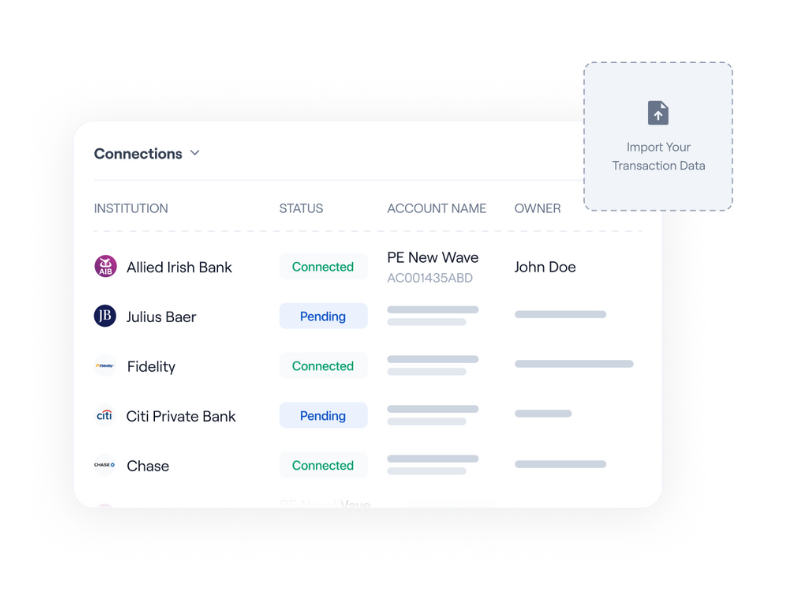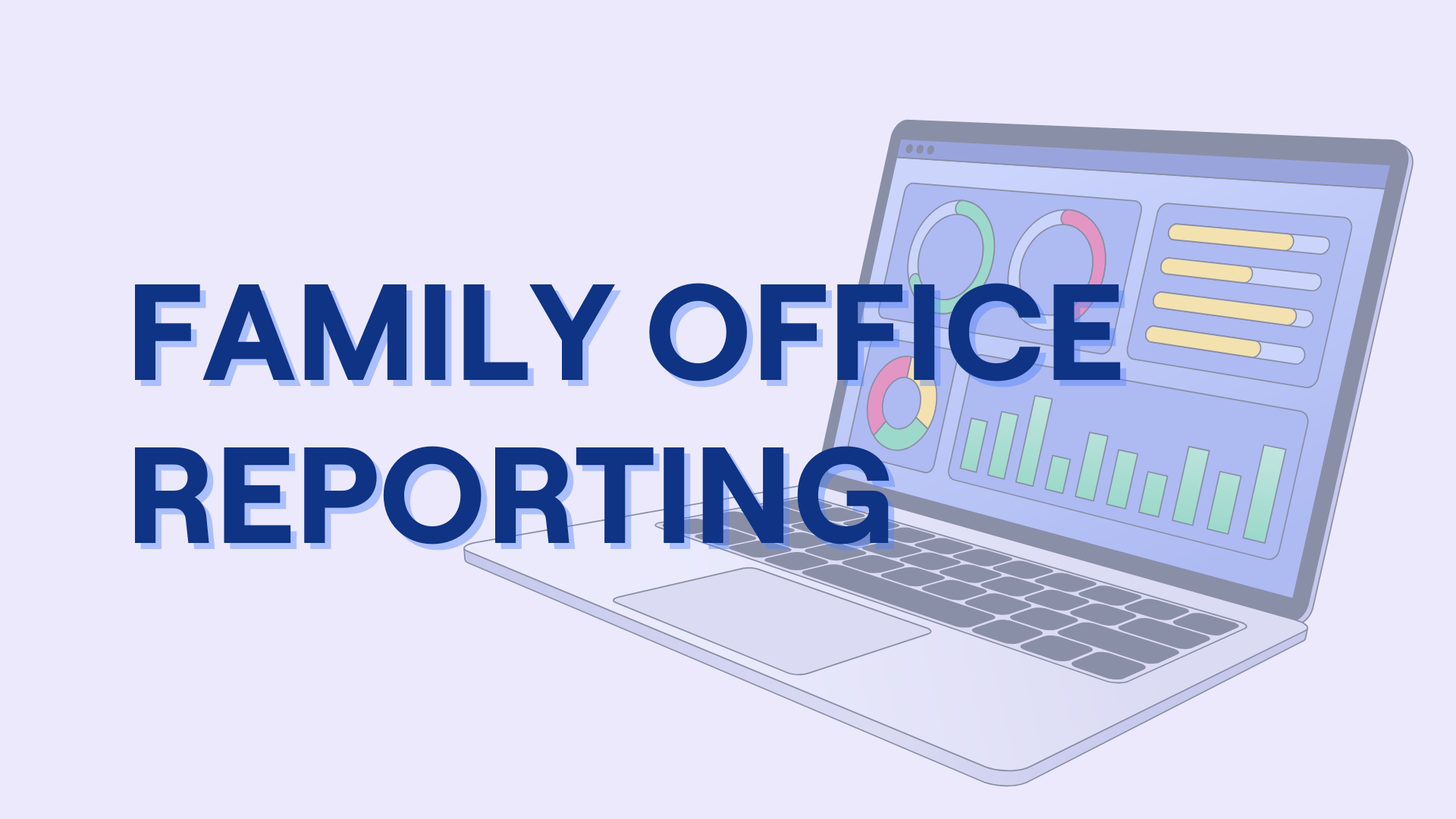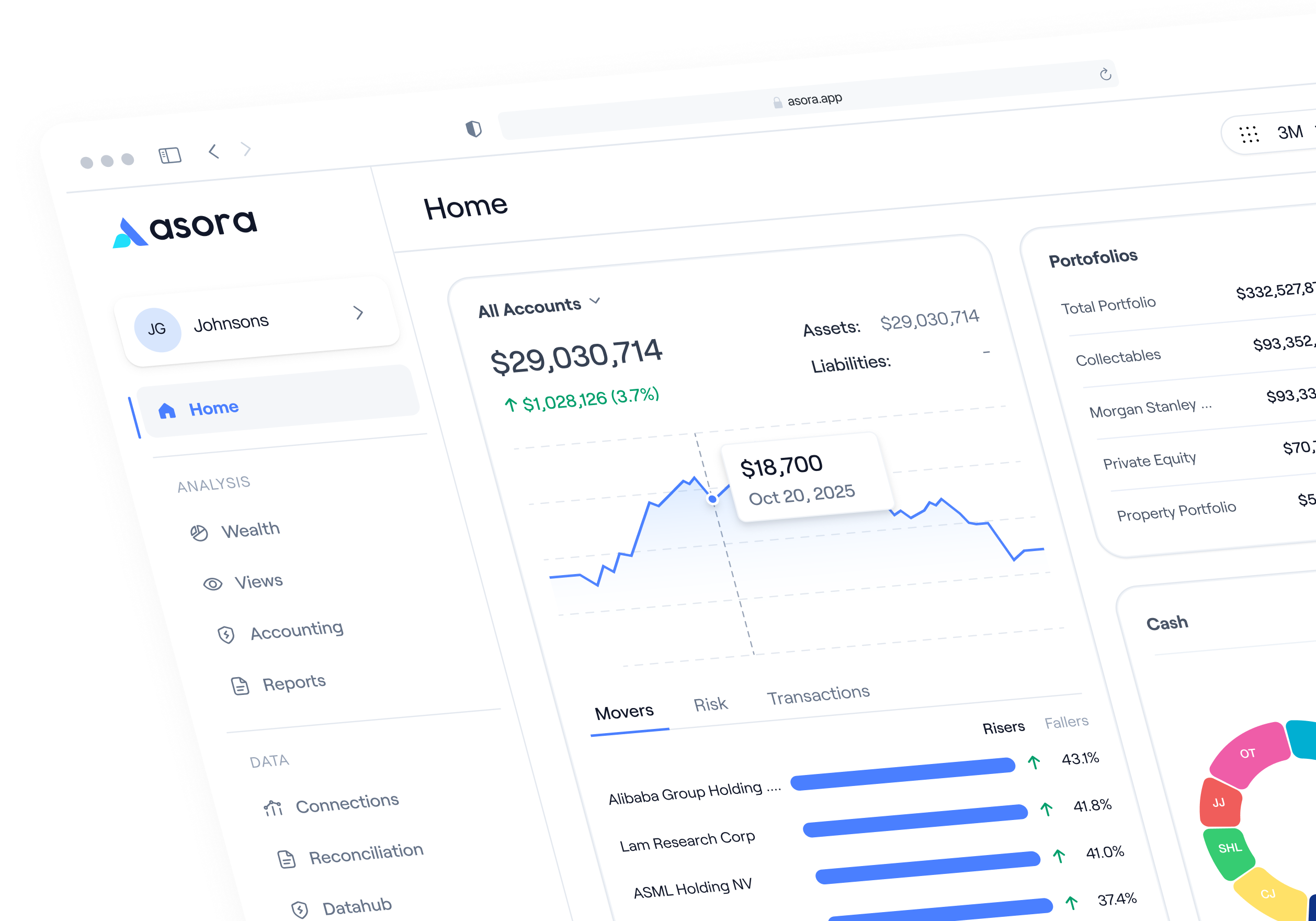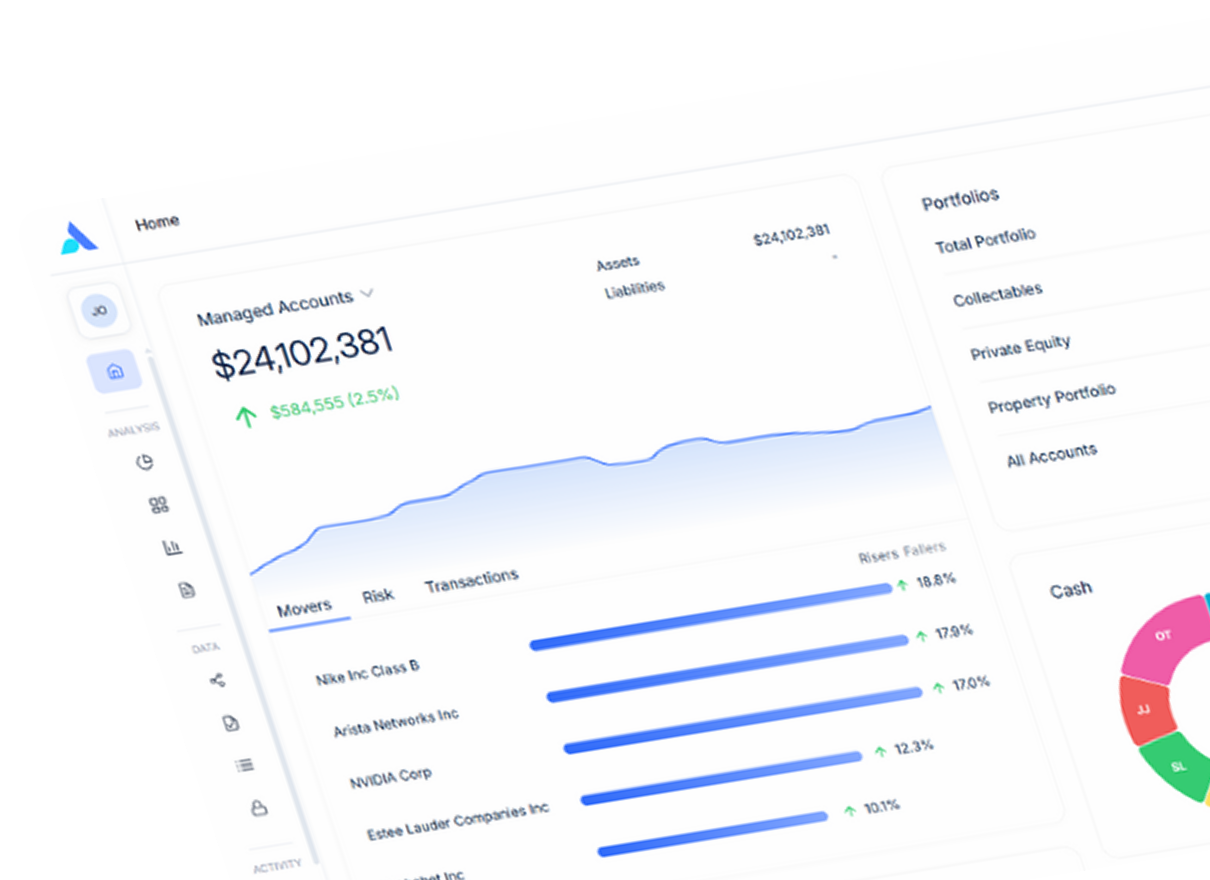Automate your family office
Schedule DemoHeading 1
Heading 2
Heading 3
Heading 4
Heading 5
Heading 6
Lorem ipsum dolor sit amet, consectetur adipiscing elit, sed do eiusmod tempor incididunt ut labore et dolore magna aliqua. Ut enim ad minim veniam, quis nostrud exercitation ullamco laboris nisi ut aliquip ex ea commodo consequat. Duis aute irure dolor in reprehenderit in voluptate velit esse cillum dolore eu fugiat nulla pariatur.
Block quote
Ordered list
- Item 1
- Item 2
- Item 3
Unordered list
- Item A
- Item B
- Item C
Bold text
Emphasis
Superscript
Subscript
TL;DR
Family office reporting doesn't have to be a manual nightmare. Modern family office software like Asora automates data aggregation across banks and custodians, tracks alternative investments in a timely cadence, and generates consolidated financial reports in minutes. This guide shows you how to eliminate spreadsheets, reduce reporting time, and give stakeholders timely insights.
Fixing the Family Office Reporting Bottleneck
Family office reporting is one of the most time-consuming operational challenges. As family wealth becomes more complex and the family office industry evolves, reporting requirements have grown more demanding and sophisticated.
Many family offices still rely on spreadsheets, email threads, and PDF statements from managers. These manual processes are slow, error-prone, and lack the flexibility needed for informed investment decisions. Legacy systems further contribute to inefficiency and data silos, making it difficult to manage and consolidate information across multiple entities.
Modern family office software can help solve this by consolidating key data on a single secure platform. Modern family offices use technology to consolidate data and streamline operations, gaining a complete picture of their wealth through automated data aggregation, reporting tools, and intuitive dashboards.
This guide explores four core areas where technology transforms reporting and drives operational efficiency:
- Data aggregation
- Performance reporting
- Financial reporting
- Alternative asset tracking
How Technology Improves Family Office Reporting
For lean teams, these four capabilities deliver the most significant lift with the least friction. Technology enables family offices to manage wealth more effectively by automating complex processes, allowing family offices to focus on strategic goals and long-term planning.
- Data aggregation and integration
- Automated workflows and task management
- Secure document management and sharing
- Performance and financial reporting
Ultimately, leveraging technology enables family offices to achieve accurate and consistent reporting, empowering them to make informed decisions and maintain transparency.
1. Data Aggregation for Family Office Reporting
Family offices typically manage financial data across dozens of sources: custodians, banks, spreadsheets, investment platforms, and private deal documents. This data arrives in inconsistent formats and at different times, requiring hours of manual entry, reconciliation, and validation. Data consolidation is essential for multi-asset portfolios, enabling family offices to unify information from diverse sources and asset classes for more comprehensive and accurate reporting.
This data arrives in inconsistent formats and at different times, requiring hours of manual entry, reconciliation, and validation. As a result, teams face inaccurate or delayed reports, fragmented visibility across asset classes, and wasted time chasing down investment data.
Automated data aggregation significantly reduces manual data handling by pulling in structured and unstructured data from key sources. Whether it’s a feed from a custodian, a spreadsheet from your family office team, or a PDF from a fund manager, the platform ingests the data and converts it into a unified format. Accounting systems and portfolio accounting work best with unified data. This allows seamless integration of financial management, performance measurement, and reporting across all assets.
With automated data aggregation, family offices can:
- Reduce manual data entry and human errors
- Pull in regular updates from banks and custodians
- Consolidate all asset data, public and private, in one place
- Consolidate wealth data from asset managers and other sources for a unified portfolio view
- Create a single source of truth for all reporting
This reduces the operational burden on your family office operations team and improves accuracy across all reporting systems.

2. Reporting for Family Offices
Even when data is collected, reporting across multiple entities, asset classes, currencies, and custodians is complex. Calculating time-weighted returns (TWR) and internal rates of return (IRR) at scale requires clear methods and consistent inputs.
Data arrives in inconsistent formats and at different times, which drives manual entry, reconciliation, and validation. The result is often delayed or inaccurate reports, fragmented visibility, and time lost chasing data.
Reporting platforms provide dynamic dashboards that update as data flows in. They automate performance calculations, document methods by asset type, and present movement bridges that separate flows, valuation changes, FX, and other drivers. Drilldowns let teams move from a consolidated view to entity, manager, strategy, region, or currency in a few clicks, with evidence linked to the positions it substantiates.
With modern reporting you can:
- Track portfolio performance across all asset classes
- Calculate TWR and IRR automatically
- Filter by entity, asset class, manager, strategy, region, or currency
- View movement bridges that isolate cash flows, valuation changes, FX, and fees
- Link statements, capital accounts, and appraisals to positions for review
- Export consolidated and entity-level report packs without manual rebuilds
Family members and investment committees gain timely insight, so reviews focus on decisions rather than compilation.

3. Alternative Asset Tracking and Reporting
Tracking private assets is one of the most time-intensive reporting requirements. Capital calls, distributions, fund valuations, and underlying holdings arrive in scattered formats with little standardization. Excel trackers become bloated, and visibility into illiquid assets exposure remains limited.
This results in incomplete views of alternative investments, a poor understanding of capital commitments and liquidity timelines, and difficulty calculating accurate IRR or NAV across multiple vintages.
Private asset tracking turns capital call PDFs, distribution notices, and Excel trackers into structured data. It captures committed capital, contributed capital, fair value, and cash flows, all mapped back to the correct entities and managers. Secure document storage is essential for compliance readiness and supports audit trails when combined with appropriate access logging and governance controls. It centralizes critical documents, keeping them organized and easily accessible for review.
Modern family office investment reporting enables you to:
- Track IRR, NAV, contributions, and distributions for each fund
- Upload and extract data from unstructured documents
- Drill down into investments by strategy, vintage, or manager
- See total exposure by manager, fund, or asset class
- Use task management tools to streamline the process of tracking alternative assets, assigning responsibilities, and facilitating collaboration among family members and advisors
Private assets become significantly easier to track and report on, improving family office reporting and analytics across your entire portfolio.

The Benefits of Modern Family Office Reporting Solutions
Family office software is built for the unique operating model of single family offices, multi-family offices, or both (depending on the provider). Whether you’re running a lean team or managing a multi-entity, multi-generational structure, the right platform reduces manual work, increases transparency, and improves data accuracy.
Key benefits include:
- All your family office data and reporting in a single source of truth
- Fewer spreadsheets, fewer errors, better data management, and wealth management
- Faster decision-making based on accurate, timely data
- Configurable dashboards and export-ready financial reports
- Secure, role-based access for family members and advisers
- Automated data aggregation across all custodians and banks
- Comprehensive reporting for performance and net worth
- Cash flow forecasting tools to support proactive decision-making
- Data security and compliance with industry standards (such as ISO 27001) to protect sensitive client information
- Flexible reporting tools and on-demand reporting empower wealth managers, improve family communications, and facilitate clear dialogue around wealth transfer and preservation
Consolidated reporting for family offices becomes easier and more accurate, helping family office operations run with clarity and control and enabling you to manage wealth more effectively.
Make Reporting Accurate with Asora
Family office reporting shouldn’t drain your team or delay decisions. When data flows automatically, performance is calculated correctly, and private assets sit alongside public markets, you get a single, trusted picture of wealth, without spreadsheet acrobatics. That’s the shift modern offices are making: from manual compilation to continuous, decision-ready reporting.
Asora helps lean teams get there fast. It pulls bank, custodian, and manager data into a single secure platform; calculates TWR and IRR across entities; converts PDFs and spreadsheets from private deals into structured positions; and produces export-ready reports on demand. The result: fewer errors, tighter controls, and more time for strategy.
If you do one thing next, do this:
- Inventory your data sources (banks, custodians, managers, private deals) and define the reports you need monthly and quarterly.
- Set role-based access for principals, trustees, and advisors so the right people see the correct view.
- Replace spreadsheet trackers with alternatives with document-linked positions and automated cash-flow tracking.
- Standardize approvals and deadlines with simple workflows to prevent end-of-month fire drills.
Want to see how it works? Schedule a demo.
Frequently Asked Questions
What are the main family office reporting requirements?
Family office reporting typically covers consolidated net worth statements, performance tracking across all asset classes, cash flow reporting, tax documentation, and compliance records. Both single- and multi-family offices also need to map ownership structures, deliver entity-level reports, and provide tailored views for different family members and stakeholders. Accurate, consistent reporting and strong data security are essential to meet regulatory requirements and ensure trust. Platforms bring these elements into a single secure, configurable workspace, so teams can deliver the right view for each audience without juggling tools.
How can family offices improve reporting efficiency?
The fastest gains in time come from automated data aggregation, which eliminates manual entry and spreadsheet reconciliations. Replacing legacy systems with a modern, consolidated reporting platform can further streamline operations and enhance accuracy. Adding family office reporting software with timely portfolio data, a single system of record, and on-demand reports can cut cycle times and reduce errors.
What should family offices look for in reporting software?
Prioritize automated aggregation from multiple banks and custodians, robust performance reporting (including private assets), secure document management, multi-entity and multi-currency support, customizable reporting, and strong security. Effective wealth data management and comprehensive risk management features are also critical for operational efficiency and compliance. Asora combines these capabilities, performance metrics like TWR and IRR, linked documents, and workflow tools, within an ISO 27001- and GDPR-aligned platform built for lean teams.
How does technology improve family office investment reporting?
Modern tools automate data collection from managers, calculate metrics such as IRR and TWR, surface live updates, and reduce manual handling errors, enabling investment decisions to happen faster and with greater confidence. Asora tracks public and private holdings side by side and highlights trends through intuitive dashboards that support timely allocation and exit calls.
What’s the difference between single-family office and multi-family office reporting needs?
Single family offices focus on one family’s wealth across entities and generations, while multi-family offices must strictly segregate data by client, maintain separate performance views, and tailor reporting per engagement, without compromising confidentiality.












